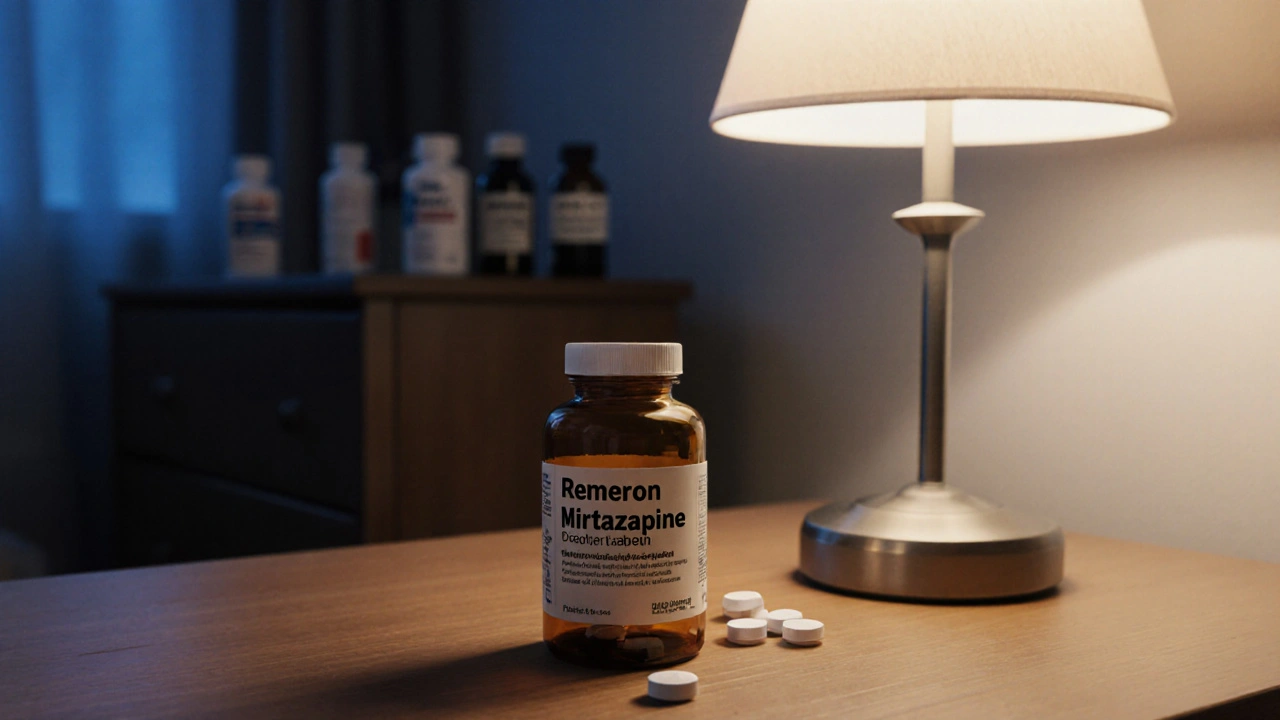Antidepressant Selection Guide
Recommended Antidepressant
How This Works
This tool evaluates your specific needs regarding daytime alertness, energy levels, pain management, sexual side effects, and budget to suggest the most suitable antidepressant from the list of common alternatives including Remeron (Mirtazapine).
Quick Takeaways
- Remeron (Mirtazapine) is a noradrenergic‑serotonergic antidepressant best known for strong sedation and appetite‑stimulating effects.
- SSRIs such as Sertraline and Escitalopram are first‑line for many patients due to mild side‑effect profiles.
- Venlafaxine and Duloxetine (SNRIs) offer dual serotonin‑noradrenaline action and are useful when pain accompanies depression.
- Bupropion is the go‑to option for those who need an energizing boost and want to avoid sexual side effects.
- Trazodone provides sedation similar to Remeron but with a lower risk of weight gain.
What Is Remeron (Mirtazapine)?
When you hear the name Mirtazapine, think of a medication that hits both serotonin and norepinephrine receptors while blocking several others, producing a calming, appetite‑stimulating effect. In the UK, it is sold under the brand name Remeron.
Remeron (Mirtazapine) is a tetracyclic antidepressant that antagonises central α2‑adrenergic receptors, leading to increased release of norepinephrine and serotonin. It also blocks 5‑HT2 and 5‑HT3 receptors, which explains its lower incidence of nausea and sexual dysfunction compared with many SSRIs.
Typical dosing starts at 15mg at night, with a usual maintenance range of 15‑45mg. Because it is highly sedating, doctors often prescribe it as a bedtime pill.
Why Look at Alternatives?
Not every patient tolerates the heavy drowsiness or the weight‑gain potential of Remeron. Some need a quicker onset, others a medication that won’t interfere with daytime alertness. Below are the most frequently considered alternatives in primary care and psychiatry.
Common Antidepressant Alternatives
- Sertraline is an SSRI that blocks serotonin reuptake, offering a mild side‑effect profile and a low risk of weight gain.
- Venlafaxine belongs to the SNRI class, boosting both serotonin and norepinephrine and is often chosen when pain is a major complaint.
- Bupropion works by inhibiting norepinephrine‑dopamine reuptake, making it energizing and less likely to cause sexual side effects.
- Trazodone is a serotonin antagonist‑reuptake inhibitor; at low doses it is primarily used for sleep, while higher doses treat depression.
- Escitalopram is an SSRI with a very favourable tolerability record and is often the first‑line choice for anxiety‑dominant depression.
- Duloxetine is another SNRI, approved for both depression and chronic musculoskeletal pain.
- Citalopram is an older SSRI similar to Escitalopram but with slightly higher dose‑related cardiac risk.
How They Stack Up - Comparison Table
| Medication | Class | Typical Dose (adult) | Onset of Mood Improvement | Common Side Effects | Weight Impact | Daytime Sedation | Cost (NHS/Private) |
|---|---|---|---|---|---|---|---|
| Remeron (Mirtazapine) | Tetracyclic | 15‑45mg nightly | 1‑2weeks | Dry mouth, constipation, increased appetite | Weight gain (+2‑4kg typical) | High (especially 15mg) | £0‑2 per tablet (NHS) / £5‑8 private |
| Sertraline | SSRI | 50‑200mg daily | 2‑4weeks | GI upset, insomnia, sexual dysfunction | Neutral | Low | £0‑1 (NHS) / £3‑6 private |
| Venlafaxine | SNRI | 75‑375mg daily | 1‑3weeks | Hypertension, nausea, sweating | Neutral | Moderate (higher doses) | £0‑2 (NHS) / £4‑7 private |
| Bupropion | NDRI | 150‑300mg twice daily | 1‑2weeks | Dry mouth, insomnia, tremor | Neutral to slight loss | Low | £0‑1 (NHS) / £5‑9 private |
| Trazodone | SARI | 150‑300mg daily | 2‑4weeks | Dizziness, priapism (rare), tachycardia | Neutral | High at low doses | £0‑2 (NHS) / £4‑7 private |
| Escitalopram | SSRI | 10‑20mg daily | 1‑3weeks | Nausea, headache, sexual dysfunction | Neutral | Low | £0‑1 (NHS) / £4‑6 private |
| Duloxetine | SNRI | 30‑120mg daily | 2‑4weeks | Dry mouth, constipation, increased blood pressure | Neutral | Low‑moderate | £0‑2 (NHS) / £5‑8 private |
When Remeron Is the Right Choice
Remeron shines in patients who struggle with insomnia, loss of appetite, or who have been through multiple SSRI trials without success. Its quick rise in serotonin and norepinephrine can lift mood faster than many SSRIs, and the added sedation helps night‑time sufferers.
However, it is not ideal for people who need to stay alert during the day (e.g., shift workers) or for those concerned about gaining weight.

How to Pick an Alternative
Use the following decision tree to narrow down a partner drug:
- Is daytime sedation a problem?
- Yes → avoid Remeron and Trazodone low‑dose.
- No → keep them in the mix.
- Do you need an energizing boost or are you dealing with fatigue?
- Yes → consider Bupropion.
- No → SSRIs or SNRIs are fine.
- Is chronic pain part of the picture?
- Yes → Venlafaxine or Duloxetine.
- No → other classes work.
- Are sexual side effects a deal‑breaker?
- Yes → Bupropion or Mirtazapine (lower sexual impact).
- No → SSRI options remain.
- Budget constraints?
- Prefer NHS‑prescribed generic SSRIs (Sertraline, Citalopram).
Always discuss liver function, cardiac history, and concomitant meds before finalising a choice.
Practical Tips for Switching
- Never stop Remeron abruptly; taper by 15mg every 1‑2weeks to avoid rebound insomnia.
- If moving to an SSRI, overlap for 1 week at half the new dose to smooth serotonin changes.
- Monitor blood pressure closely when starting Venlafaxine or Duloxetine.
- Check for drug‑drug interactions with MAO inhibitors-maintain a 14‑day washout.
- Keep a symptom diary for at least 4 weeks to capture efficacy and side‑effect trends.
Frequently Asked Questions
Can I take Remeron with an SSRI?
Combining a tetracyclic like Remeron with an SSRI raises the risk of serotonin syndrome. Doctors usually avoid this combo unless the SSRI dose is very low and the patient is monitored closely.
Why does Remeron cause weight gain?
Mirtazapine blocks histamine H1 receptors, which stimulates appetite and reduces metabolic rate. The effect is dose‑dependent-lower doses tend to cause more weight gain.
Is Bupropion safe for people with a history of seizures?
Bupropion lowers the seizure threshold, especially at doses above 300mg per day. Patients with prior seizures should use it only under strict supervision or choose another class.
How fast does Venlafaxine work for depression with pain?
Most people notice mood improvement within 1‑2weeks, while analgesic benefits may take 3‑4weeks as the drug builds up in the nervous system.
Can I use Trazodone as my sole antidepressant?
Yes, at doses above 150mg daily Trazodone works as a full antidepressant, but many clinicians prefer it for insomnia and pair it with another agent for stronger mood lift.
Bottom Line
Remeron (Mirtazapine) remains a solid option for patients needing sedation and appetite stimulation, but its side‑effect profile pushes many clinicians toward newer SSRIs, SNRIs, or the energizing bupropion. By weighing factors like daytime alertness, weight concerns, pain comorbidity, and cost, you can land on the drug that fits your lifestyle and health goals.









Thank you for the thorough breakdown; the table is especially useful 😊.
When we weigh the trade‑offs between sedation and daytime alertness, it becomes a microcosm of the larger philosophical question: do we prioritize immediate comfort or long‑term productivity? The guide nicely captures that tension, especially the way it flags weight gain as a downstream ethical concern for patients who already struggle with body image. I also appreciate the nod to individualized decision‑making – it respects the lived experience behind each prescription. Ultimately, the best choice is the one that aligns with a person’s values, not just a generic side‑effect profile.
Sure, let’s all sit in a circle and discuss how “values” magically solve the problem of a drug that makes you feel like a couch potato. If you love philosophical musings, great, but you still have to eat, sleep, and maybe show up for work without looking like a sleepy panda. The guide’s decision tree is fine until you realize most patients aren’t philosophers, they’re people who need a medication that won’t turn dinner into a midnight buffet. So, while I love the lofty talk, I’d rather see a blunt warning: "Mirtazapine = heavy sedation, expect weight gain" – no need for a symposium on ethics.
Honestly, prescribing a drug that encourages overeating feels morally negligent, especially when cheaper, weight‑neutral options exist.
Yo, i get ur point but sometimes doc's gotta start somewhere. Mirtazapine works for lots of peopel, weight gain is a price we pay, lol. +++
Choosing the right antidepressant is rarely as simple as picking a flavor of ice cream, and the nuances presented in this guide deserve a deep dive. First, consider the patient’s chronotype: someone who naturally struggles with insomnia may actually benefit from the sedative profile of Mirtazapine, turning a potential side effect into a therapeutic advantage. Second, we must examine comorbid conditions; for instance, a patient with chronic low back pain might find an SNRI like Duloxetine or Venlafaxine more effective because those agents target both mood and nociceptive pathways. Third, the impact on metabolic health cannot be ignored – the weight‑gain propensity of Mirtazapine is dose‑dependent, with lower doses often causing more histamine‑mediated appetite stimulation, whereas higher doses may lessen this effect, albeit at the cost of increased sedation. Fourth, sexual dysfunction remains a frequent reason for non‑adherence; paradoxically, both Mirtazapine and Bupropion have relatively lower sexual side‑effect profiles compared to many SSRIs, making them suitable for patients who prioritize sexual health. Fifth, the financial aspect – while many SSRIs are available generically at negligible cost on the NHS, newer agents like Vortioxetine may present a barrier for patients without supplemental insurance. Sixth, drug–drug interactions are paramount: Mirtazapine’s metabolism via CYP2D6 can be altered by concurrent inhibitors, potentially leading to higher plasma levels and exacerbated sedation. Seventh, the timeline of therapeutic onset matters; patients in acute crisis may require a medication with a quicker onset, such as certain SNRIs, whereas those with a more chronic, stable presentation might tolerate the slower onset of Mirtazapine. Eighth, consider the patient’s age – elderly individuals are more susceptible to anticholinergic burden and orthostatic hypotension, making the low‑sedation SSRIs a safer first‑line choice. Ninth, the presence of suicidality demands careful monitoring; some clinicians avoid initiating Mirtazapine in highly suicidal patients due to the risk of increased energy before mood improves, which could theoretically heighten impulsivity. Tenth, patient preference and lifestyle play a decisive role: shift workers, for example, may find the daytime sedation unacceptable, whereas night‑shifters could view it as a benefit. Eleventh, monitoring parameters differ: SNRIs often require routine blood pressure checks, while SSRIs may necessitate periodic ECGs at higher doses. Twelfth, the tapering strategy is non‑trivial; abrupt cessation of Mirtazapine can precipitate rebound insomnia, so a gradual reduction is essential. Thirteenth, the potential for serotonin syndrome when combining serotonergic agents must be weighed, especially if polypharmacy is in play. Fourteenth, we should not forget the psychosocial context – access to therapy, support systems, and patient education can tilt the balance toward one medication over another. Finally, the clinician’s own familiarity and comfort with a drug class influence prescribing patterns; a well‑versed prescriber may achieve better outcomes with a medication they understand deeply, even if it isn’t the textbook first‑line option. All these layers underscore why a one‑size‑fits‑all chart, while helpful, must be supplemented by nuanced clinical judgment.
Wow, that was a marathon of insights! 🤯 I really appreciate the thoroughness – it helps demystify the decision‑making process for folks who feel overwhelmed by the options.
Ever notice how the "big pharma" narrative conveniently hides the fact that SSRIs are pushed because they’re cheap, mass‑produced, and keep patients dependent?; The industry loves a drug that can be marketed as a "miracle" while ignoring the severe withdrawal syndromes that follow abrupt discontinuation!!!; It’s no coincidence that the most lucrative patents are on brand‑name molecules, not the generic ones that actually work without the baggage.
While it’s true that marketing influences prescribing trends, the clinical data supporting SSRIs’ efficacy in many cases is robust. The key is to balance evidence‑based practice with individual patient factors, and tools like the comparison table help mitigate bias by presenting objective side‑effect profiles.
Great discussion, everyone! Keep sharing your experiences – they’re the real guide for us all 😊.